Renting Trees Keeps the Christmas Spirit Alive
Air Date: Week of December 12, 2014
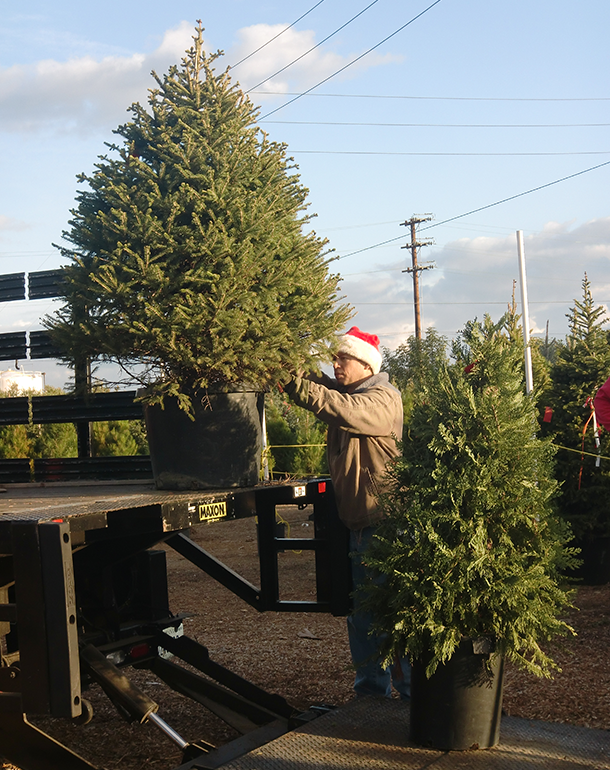
When they’re not adorning the living rooms of California residents, the living Christmas trees are kept in pots on a brownfield (previously industrial) site that serves as the company’s nursery. (Photo: Scott Martin)
For Scott Martin, the joy of Christmas was spoiled by the sight of discarded trees in the trash in the New Year, so he founded a company that rents living Christmas trees. His alter ego “Scotty Claus” tells host Steve Curwood why renting a living tree is better for the environment and how it captures the spirit of the season.
Transcript
CURWOOD: Some 90 million American households say it wouldn’t be Christmas without a tree, and though the majority of them are fake, about 33 million homes get a real tree. There’s an ongoing debate as to whether fake or real is better for the environment. Real trees are green and great-smelling compared to their plastic cousins, but cut trees are sometimes grown far from where they are sold, and they drop needles all over the floor. And, of course, cut trees are dying trees: they’re grown for seven to ten years, then chopped down, decorated for just a month and thrown away. Well, there’s an alternative to cutting down a seasonal pine or fir or spruce: rent a living Christmas tree. It’s the brainchild of Scotty Claus. Welcome to Living on Earth, Scotty.
MARTIN: Well, thank you for having me.
CURWOOD: So you call yourself Scotty Claus. What about the other folks at your company?
MARTIN: Oh, everyone at my company has a fun name whether it be Dean Jingle, Kristen Kringle, Tonya Twinkle, Justin Season, Greg Nog.
CURWOOD: Greg Nog? Justin Season? [LAUGHS] Now, what gave you this idea of renting Christmas trees?
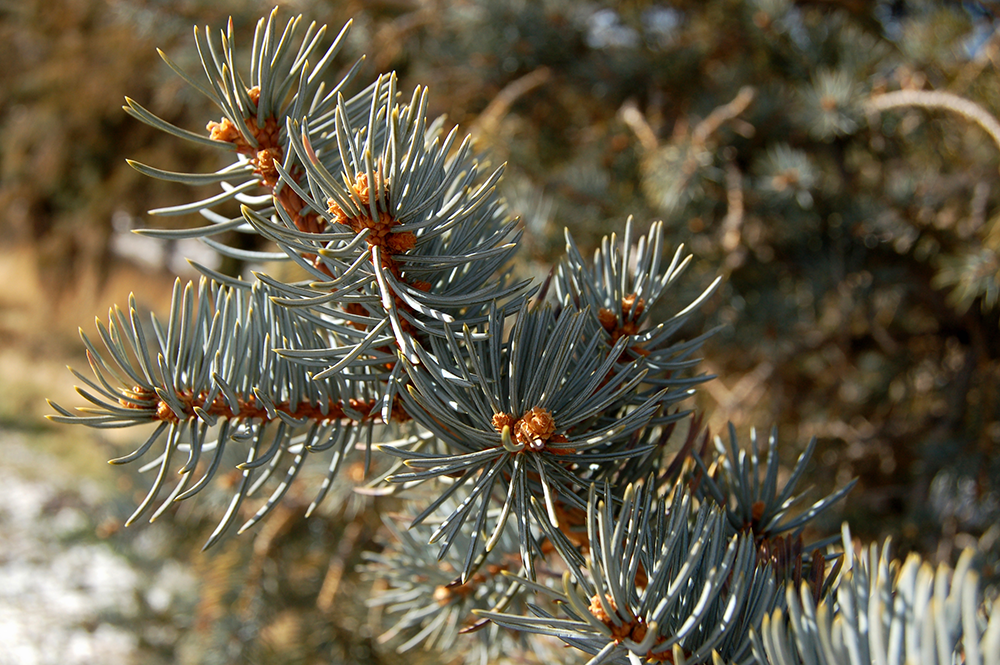
The Colorado blue spruce is hardy and drought-tolerant, with strong branches that don’t droop under the weight of Christmas ornaments. It’s become a key species in The Living Christmas Company’s stock. But be careful! Those needles are sharp – so Scotty Claus recommends wearing gardening gloves while decorating the tree. (Photo: Tony Frates; Flickr CC BY-NC-SA 2.0)
MARTIN: It started when I was a kid, and there was no more fun you can have as a teenager delivering Christmas trees. Everybody's happy to see you. It really means that Christmas is begun in the house. So it was just a ton of fun and you can't complain about the tips. The problem was that the intense joy you felt was sort of curbed when a couple of weeks later I’d see that same tree that I struggled to get to the second storey of this person's house thrown out like the trash. I had been working there since I was 15 and thought "Why can't we do this with living trees?" I kept trying over the years, and I would give someone for Christmas an avocado tree to decorate or different varieties of trees and I kept trying until I felt like, hey, I've got a combination that will work and started a website called livingxmas.com and away we were.
CURWOOD: How exactly does your rent-a-Xmas-tree business work?
MARTIN: So, everything's online. You can choose your size and variety, and what our back end does is put in an efficient route, put 20, 30 trees on one truck, and reduce our footprint by delivering those trees more efficiently.
CURWOOD: How big are these trees?
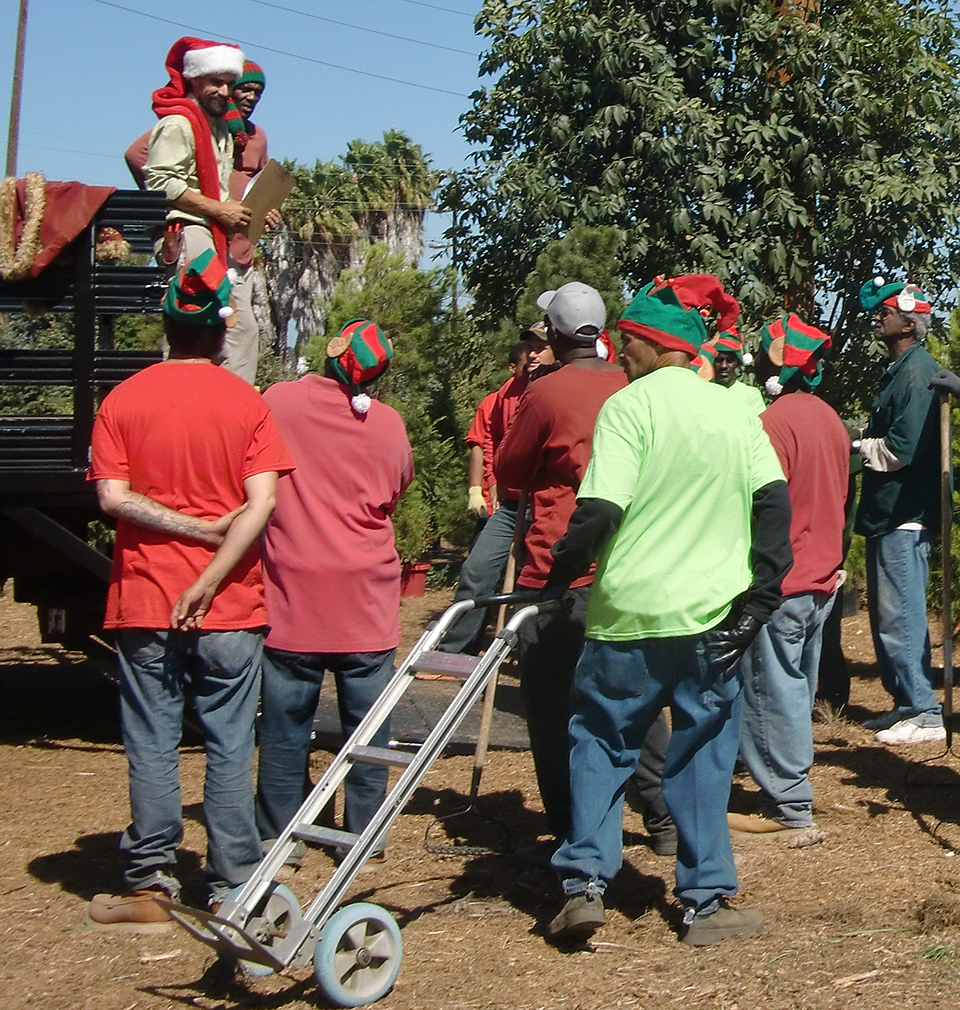
“Scotty Claus” talks with a group of his employees, or “elves.” The largest trees, which can be fifteen feet, require the teamwork of up to eight “elves” to move. (Photo: The Living Christmas Company)
MARTIN: We've got all varieties and sizes. We got them as small as a two to three foot, but, you know, we've got some large residences and institutions getting them all the way up to 15 feet.
CURWOOD: Fifteen feet...that's a lot of tree.
MARTIN: That's a lot of tree and a lot of roots to support that.
CURWOOD: So how do you get that, do you use a forklift. I mean, how do you get that thing around?
MARTIN: Each of the trucks already has a liftgate on it and then a pallet jack. The limiting factor is the weight. They can weigh over a ton. We have a certain gentleman that does pay for his second-storey delivery, and it takes about eight elves and we called it our "Free Willy" delivery because we have to put in the gurney to get up the stairs, but we're able to do it.
CURWOOD: Then what happens when the holidays are over?
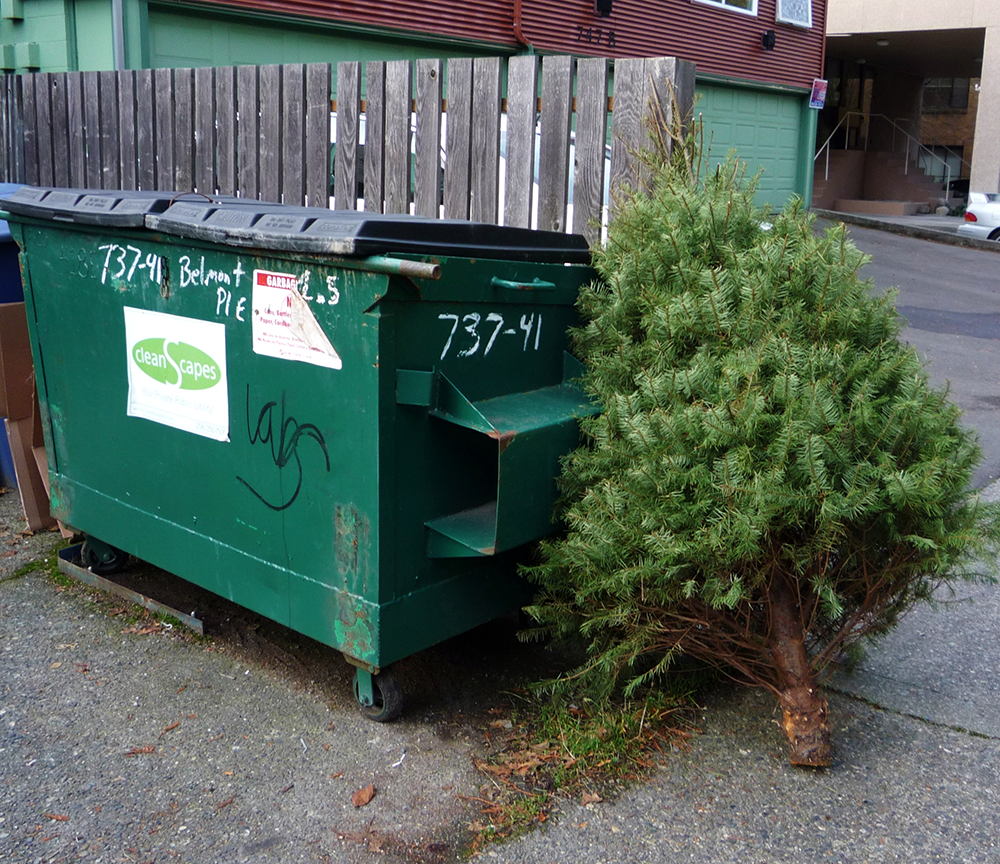
As a teenager who delivered Christmas trees to earn a little extra cash, Scott Martin hated seeing the same trees he’d delivered “thrown out like the trash. And I’d been working in a nursery since I was fifteen, and thought, why can’t we do this with living trees?” (Photo: sea turtle; Flickr CC BY-NC-ND 2.0)
MARTIN: So our elves pick them back up again and then they go to my lot. Currently we're able to use brownfields, so it's land that's been contaminated, or its future use makes it unsuitable for development. But our trees all have their own soil and are above ground, so we're able to return where nothing was going on into a forest in an urban area.
CURWOOD: And how true is it that when you fertilize these trees the rest of the year that you using, well, stuff from reindeer?
MARTIN: Yeah. [LAUGHS] Reindeer droppings have a special content to it that makes these magically grow faster, it’s true.
CURWOOD: Now, your business is there in California and to grow trees you need water, well, and water is not in great supply there, so how do you grow these trees?
MARTIN: What we've done...we've recently found that the Colorado Blue Spruce... it's one of the more traditional looking trees, looks like a traditional Noble Fir...holds ornaments great. In Southern California it didn't make the books as a tree that does really well here probably as defined by nurseries because it's such a slow-growing tree, but we found for our needs it's perfect that it's slow-growing and being slow-growing also doesn't require water in the same way that the other trees do. It's got a grey-green foliage so that also indicates is not quite as thirsty which makes it a perfect candidate for what we're doing and so we're slowly move our inventory towards different varieties of spruces.
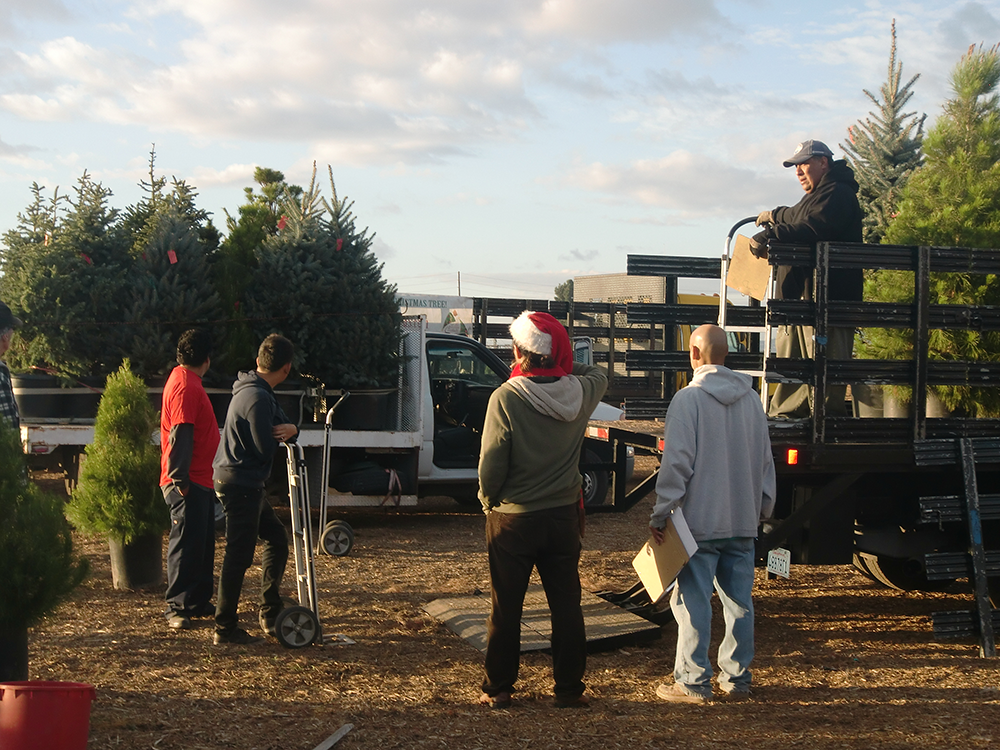
“Last year, we employed sixty people for the Christmas season [who] probably wouldn’t have had jobs otherwise,” Martin said. (Photo: The Living Christmas Company)
CURWOOD: What about somebody wants to buy a Fir or a Pine or something? What if they don't want the drought-resistant variety?
MARTIN: Yeah, so we inform our customers. A big part of this is setting expectations and informing them. We've chosen trees that grow locally in the area, either native or adaptive, and we still do offer two pine trees - an Aleppo Pine and a Monterey Pine - both are relatively adaptive to the California climate. They're not water thirsty, they just take more care and more water than the Spruce. There's a Cypress that we offer as well which is fairly drought tolerant. So just by nature of us choosing trees that grow in Southern California, that are native or adaptive, means they are going to need less water, and we've increased our number of Spruces to sort of push in that direction.
CURWOOD: Now, I wondering what kind of of hazard insurance you offer with the Blue Spruce since they're so prickly. I mean, you lean up against one and "ouch!"
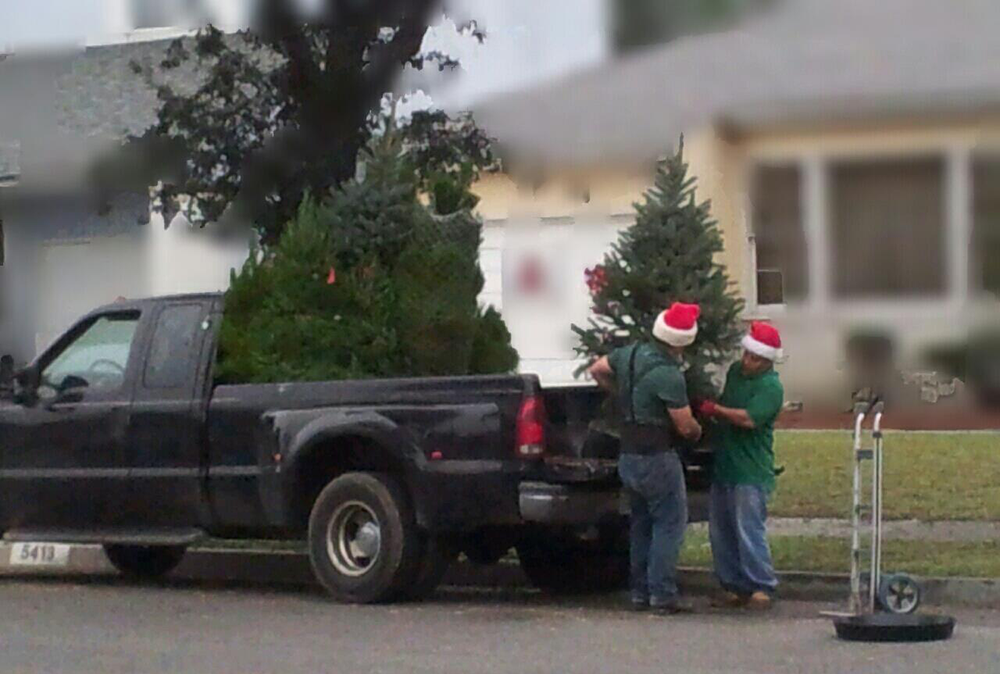
The Living Christmas Company packs 20 to 30 trees onto one truck and delivers them right to your door. (Photo: Scott Martin)
MARTIN: Yeah, Blue Spruce are a bit more prickly, but there's probably seven or eight varieties of the Colorado Blue Spruce that we've been using and trying to get little less sharp varieties into the mix, but we also recommend that you decorate with some gardening gloves and you'll be just fine.
CURWOOD: If I'm your client, Scotty, how likely is it that I could get the same tree year after year?
MARTIN: That's one of our most difficult programs, but most wonderful programs as well. With technology improving, we've able to geotag our trees so as they come in and someone's requested the same tree we're able to track its wherabouts in the nursery. Of course, we can't guarantee that same tree is going to be a premium tree for the following year, and so far the definition of a Christmas tree is still pretty perfectly conical and can't have gaping holes or dead spots, so in being a living tree we can't guarantee that, but most of our clients are pretty understanding of the flexibility required for having a living tree in their home.
CURWOOD: Now, how soon do you have to retire these rental trees?
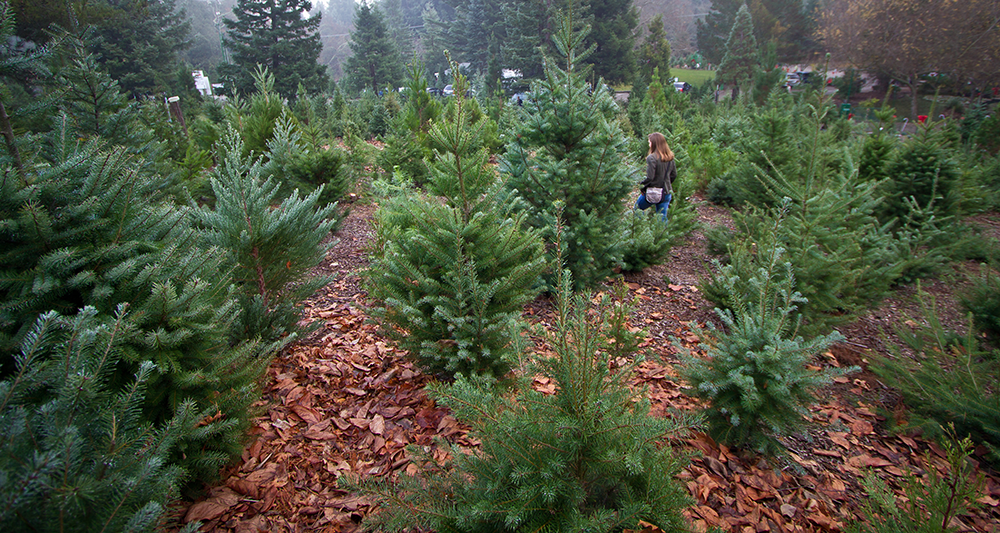
There are approximately 350 million Christmas trees growing on tree farms in the U.S. (Photo: anthony_goto; Flickr CC BY-NC-ND 2.0)
MARTIN: We don't have great numbers on that. We assume between five and 10 percent of the trees will not be with us for the following year just because of transportation costs and sometimes there's forgetfulness from our customers of, you know, how often they water. You're asking a lot of the tree to come inside a home. In southern California, it doesn't drop below maybe 40 degrees outside then it goes from 80 degrees inside then back out to cold temperatures it can be stressful, but so far we've, like I said, retained 90 percent of our trees from to year so we don't necessarily know the numbers on what the retirement rate is going to be in the future.
CURWOOD: Scotty, how much of a selling point is the green or environmental aspect of your business?
MARTIN: You know, it's a really strong part of it in that the stories I hear are those that have forgone getting a tree altogether because they're not comfortable cutting down a tree to bring it in their home and an artificial tree just doesn't say Christmas like the symbol they had when they were a kid. And so I've got people writing me e-mails or phone calls, and one year it was this woman in tears and said, "Since I moved out to LA, as a single woman I couldn't get a tree into my house on my own. I really don't believe in cutting down a tree. I'm just not going to buy a plastic tree and so this is the first time I've celebrated Christmas in 10 years,” and creating, recreating that connection is really special for us.
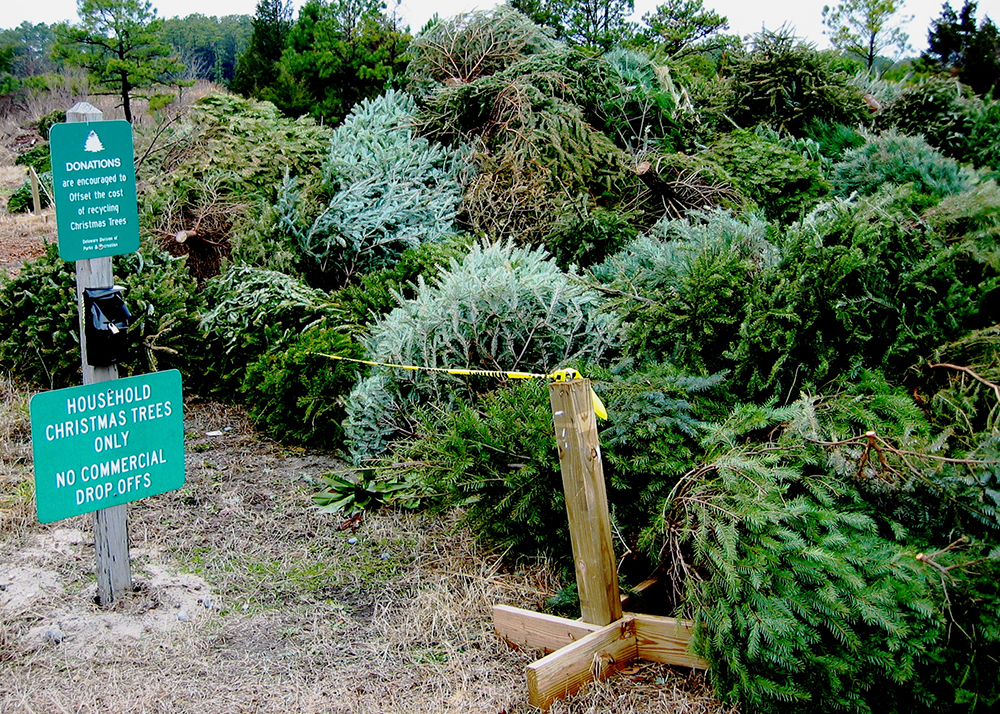
It’s estimated that at the end of the season, 9 of 10 cut Christmas trees are recycled in some way, yielding mulch, compost, and even habitat for fish! (Photo: Mike Mahaffie; Flickr CC BY-NC-ND 2.0)
MARTIN: What we talk about more than the environmental side of it is just what value do you have or what value do you want to teach your kids? Yes, we're saving a tree, but it's really about what's a symbol of a tree mean in the first place, and how important is it to you to have something living at the end of the year that goes on living into next year? When I look at these trees, you know, I can walk my lot, and I know that tree has sometimes been with two or three different families in part of different Christmas celebrations and so that's been able to go into that tree. I also know last year we employed 60 people in the Christmas season that probably wouldn't have had jobs otherwise, and so to me some of the special parts is that beauty of the tree that's going into it.
CURWOOD: I imagine you've developed a bit of a connection with these trees over time? You're naming them I think I heard?
MARTIN: Yeah. One of the things I enjoy most is going through and reading all the different names, you know, like Gangster Lean and Spruce Lee, Treesus Agustus, Little Baby Treesus, and reading what people name their trees is really one of the fun parts of the job.
CURWOOD: Oh, the customers name the trees.
MARTIN: The customers name the trees, yeah, that's...when you adopt a tree, you have to give it a Christmas name. And so the names they come up with are really wonderful.
CURWOOD: And so they must feel pretty strongly about getting that same tree back the next year?
MARTIN: It's a challenge when you raise that bar of of hope and expectation, but we do our best and try to keep a jolly disposition while doing it.
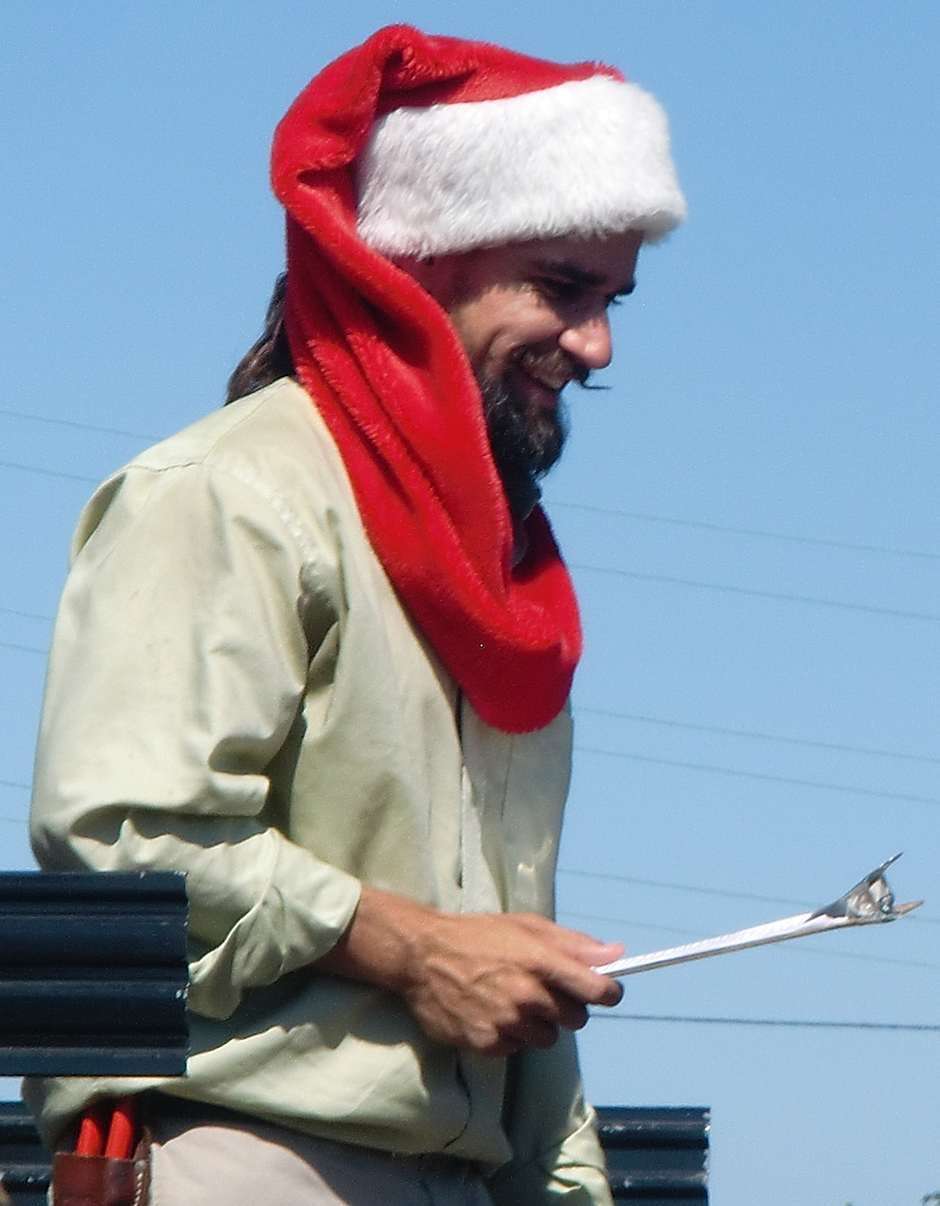
Scott Martin, aka “Scotty Claus,” is the founder of The Living Christmas Company, which rents potted Christmas trees to California residents and businesses. (Photo: The Living Christmas Company)
CURWOOD: But what if Wilbur isn't available this year?
MARTIN: We always give people the option of...if Fred can't make it maybe Frederica?...if Tiny Tim can't return back home, maybe Tim Senior can do the trick? So instead of a "no," or "your tree passed," it's an opportunity for a new beginning or a new relationship.
CURWOOD: Alright, before you go, tell me about the most fun installation that you had one of your rental trees?
MARTIN: I think one of the most touching ones was actually when I went to pick up the tree afterwards and the child sort of holding onto the tree, like hugging it, in tears like, you know, “can't we keep the tree, can it stay”, you know, sort of convincing her that the tree can come back next year. Having named it and taken care of it and watered it, the child really created a connection with the tree and it couldn't help but bring tears to my eyes just watching that unabashed love of the tree and had to convince him that the tree could come back next year.
CURWOOD: Scotty Claus, also known as Scott Martin for the rest of the year, is the founder of the Living Christmas Company, Christmas tree rental firm in California. Thanks so much for taking the time, Mr. Claus.
MARTIN: Absolutely. Thank you and Merry Christmas.
CURWOOD: Happy New Year!
Links
10 Ways to reuse your Christmas tree
How Green Is Your Artificial Christmas Tree? (New York Times)
Living on Earth wants to hear from you!
Living on Earth
62 Calef Highway, Suite 212
Lee, NH 03861
Telephone: 617-287-4121
E-mail: comments@loe.org
Newsletter [Click here]
Donate to Living on Earth!
Living on Earth is an independent media program and relies entirely on contributions from listeners and institutions supporting public service. Please donate now to preserve an independent environmental voice.
NewsletterLiving on Earth offers a weekly delivery of the show's rundown to your mailbox. Sign up for our newsletter today!
 Sailors For The Sea: Be the change you want to sea.
Sailors For The Sea: Be the change you want to sea.
 The Grantham Foundation for the Protection of the Environment: Committed to protecting and improving the health of the global environment.
The Grantham Foundation for the Protection of the Environment: Committed to protecting and improving the health of the global environment.
 Contribute to Living on Earth and receive, as our gift to you, an archival print of one of Mark Seth Lender's extraordinary wildlife photographs. Follow the link to see Mark's current collection of photographs.
Contribute to Living on Earth and receive, as our gift to you, an archival print of one of Mark Seth Lender's extraordinary wildlife photographs. Follow the link to see Mark's current collection of photographs.
 Buy a signed copy of Mark Seth Lender's book Smeagull the Seagull & support Living on Earth
Buy a signed copy of Mark Seth Lender's book Smeagull the Seagull & support Living on Earth

